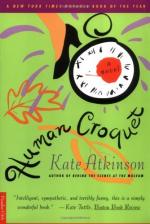|
This section contains 498 words (approx. 2 pages at 400 words per page) |

|
Human Croquet Summary & Study Guide Description
Human Croquet Summary & Study Guide includes comprehensive information and analysis to help you understand the book. This study guide contains the following sections:
This detailed literature summary also contains Topics for Discussion and a Free Quiz on Human Croquet by Kate Atkinson.
The novel Human Croquet presents the story of Isobel Fairfax, her family, and friends in 1960 England. Isobel as principle narrator tells a story that moves forward and backward through history. The story begins on April 1, 1960, Isobel's sixteenth birthday.
In a short introductory chapter Isobel tells the history of her region of England, the town of Lythe. She goes far back into English history and chronicles the sixteenth century figure Sir Francis Fairfax, who built his manor in the area of Lythe and married Lady Fairfax. After the decline of Fairfax manor, the descendants of Sir Francis remained in the area, and their fortunes waxed and waned. Isobel's family's current house, Arden, stands on the location of what was once Fairfax Manor.
Isobel has a brother named Charles, who is fascinated by topics generally regarded as science fiction. His particular interests center on alien abductions. This may be due in part to the disappearance of Charles and Isobel's mother, Eliza, when they were young. They also lost their father, Gordon, for a seven-year period immediately following the disappearance of their mother.
Isobel's presentation of history is not linear. The narrative often moves back in time. These presentations of past events are most often told by an unnamed third person narrator, while Isobel's presentation in the present is delivered in first person. Sometimes Isobel herself experiences what her and Charles refer to as time warps. Suddenly for brief moments Isobel will find herself in various periods of the past before returning to the present. These time warps come without warning, and often the scenes she witnesses are without explanation.
In one of the sections that covers the past, the cause for Isobel and Charles's mother's disappearance is revealed. The children witness her murder, but they are so young that they do not understand what they have seen, and they seem to have repressed the memory as they grow up. They believe the various stories that their father, grandmother, and aunt tell them regarding their mother's departure. They also believe their grandmother and aunt's story that their father died in a fog in London until one day, without warning, seven years later, Gordon returns home with a new wife.
As the novel progresses, the plot becomes increasingly surreal. The narrative continues to move back and forth in time, and Isobel experiences the same events over and over, and one of the events involves the death of a friend. Explanations for certain events are provided, but just as often revisions in the plot reveal that some events never happened. The surreal element of the plot intensifies until at last the revelation of one particular event in Isobel's life provides an explanation for most inconsistencies.
The latter chapters provide additional historical accounts of the Fairfax family, and in a final chapter, Isobel reveals what happened to all of the principle characters. Through all of the delightful twists and turns, Isobel delivers a deeper message about the nature of imagination.
Read more from the Study Guide
|
This section contains 498 words (approx. 2 pages at 400 words per page) |

|



